Technology for Obtaining Sintered Components with Tailored Electromagnetic Features by Selective Recycling of Printed Circuit Boards
Abstract
:1. Introduction
2. Materials and Methods
2.1. Manufacturing and Characterization Equipment
- Sintering was performed by use of the Spark plasma sintering furnace HHP D (FCT Systeme Gmbh, Rauenstein, Germany).
- A simultaneous thermal analyzer—Thermogravimetry (TG)/Differential Scanning Calorimetry (DSC) type STA 449 F3 Jupiter, (NETZSCH, Selb, Germany)—allowed the determination of mass variations and thermal changes for different types of materials, including inhomogeneous materials.
- Hydrostatic density was determined utilizing XS204 Analytical Balance, characterized by the following specifications: maximum capacity of 220 g, precision of 0.1 mg, linearity of 0.2 mg, internal calibration, equipped with a density kit for solids and liquids, and an RS 232 interface. The measurements were conducted at a temperature of 25 °C.
- Chemical analysis was performed by use of the XRF spectrometer model WD-XRF S8 TIGER-1 kW (Bruker AXS GmbH, Berlin, Germany).
- Structural characterization was carried out by X-ray diffraction (XRD) using CuKα radiation (λ = 0.154 nm) with Ni filter Bruker AXS D8 Advance (Bruker AXS, Billerica, MA, USA). Diffraction patterns were recorded at room temperature in Bragg–Brentano geometry at an angle 2θ from 20° to 65° at a rate of 0.6°/min (2θ)/min.
- Scanning electron microscopy (SEM) was performed with a field emission and focused ion beam scanning electron microscope (SEM) model Tescan Lyra III XMU (Brno-Kohoutovice, Czech Republic).
- Shore hardness tests were performed with a common Microdurometer Vickers FM700 (Future-Tech Corp, Tokyo, Japan).
- Dielectric analysis was performed via broadband dialectic spectroscopy, by use of a Turn Key Dielectric Spectrometer BDS 40BDS (frequency band 3 μHz–3 GHz), with variable temperature control (Novocontrol Gmbh, Montabaur, Germany).
2.2. Powder Manufacturing Process
3. Results and Discussion
3.1. Thermal Analysis for Powders
3.2. Evaluation of Hydrostatic Density of Powders before Sintering Process
3.3. Chemical Analysis of Powders via Spectrometry with X-ray Fluorescence—XRF
3.4. X-ray Diffraction (XRD) Analysis of Disks
3.5. Evaluation of Vickers Hardness of Disks
3.6. SEM Images and Evaluation of the Chemical Composition of Disks Carried Out by the Use of the EDS Probe
- −
- The elements Al, Si, Ca, Cu, Mg, Fe, Cr, Ni, Sn and Pb were identified in all disk samples in all areas, e.g., Al (with a maximum percentage of 44.59% in the case of area 2 of P2, a value close to the maximum also being identified in the case of area 5 of P1, namely 44.52%); Si (with a maximum percentage of 47.42% in the case of area 2 of P3); Cr (with a maximum percentage of 18.9% in the case of area 3 of P1); Fe (with a maximum percentage of 68.09% in the case of area 5 of P1, and 62.37% in the case of area 7 of P1); Ni (with a maximum percentage of 19.96% in the case of area 2 of P1); and Cu (with a percentage of 9.98% in the case of area 1 of P3).
- −
- There are elements that appear only in limited areas: Ti, with a maximum percentage of 5.86% in the case of area 2 of P2; Zn, with a maximum percentage of 8.43% in the case of area 1 of P3; K, which appears only in the case of, e.g., area 1 of P2 with a percentage of 0.48%; Mn, which appears only in the case of, e.g., area 3 of P1 in a percentage of 0.85%; Al, which appears only in the case of, e.g., area 2 of P3 with a percentage of 0.63%; and Br, with a maximum percentage of 5.57% in the case of area 1 of P1.
- −
- The presence of precious metals is also found, such as the following: Ag, in all areas, with a minimum percentage of 0.59%, e.g., in P1—area 1, and a maximum percentage of 1.63% in P3—area 2; Pt, only in limited areas, with a maximum percentage of 0.89%, e.g., in the case of P1—area 2; and Au, in many areas, with a maximum percentage of 0.96%, e.g., in the case of P3—area 5.
3.7. Dielectric Tests
4. Conclusions
Author Contributions
Funding
Data Availability Statement
Conflicts of Interest
References
- Available online: https://www.eea.europa.eu/policy-documents/thematic-strategy-on-the-prevention (accessed on 6 June 2024).
- Available online: https://www.eea.europa.eu/policy-documents/thematic-strategy-on-the-sustainable (accessed on 6 June 2024).
- Directive 2002/96/EC Regarding Electrical and Electronic Equipment Waste. Available online: https://www.eumonitor.eu/9353000/1/j4nvk6yhcbpeywk_j9vvik7m1c3gyxp/vitgbgibgvwc (accessed on 6 June 2024).
- Available online: https://weee-forum.org/iewd-about/#:~:text=According%20to%20the%20latest%20UN’s,82%20billion%20kg%20by%202030 (accessed on 6 June 2024).
- Directive 2012/19/EU on Waste Electrical and Electronic Equipment (WEEE). Available online: https://eur-lex.europa.eu/legal-content/EN/TXT/PDF/?uri=CELEX:32012L0019 (accessed on 6 June 2024).
- Martinho, G.; Pires, A.; Saraiva, L.; Ribeiro, R. Composition of plastics from waste electrical and electronic equipment (WEEE) by direct sampling. Waste Manag. 2012, 32, 1213–1217. [Google Scholar] [CrossRef] [PubMed]
- Gerne, G.; Carbajosa, J.R. Electrical and Electronic Waste (E-Waste) Dismantling and Recycling Manual; Technical Report; United Nations Development Programme: New York, NY, USA, 2022. [Google Scholar] [CrossRef]
- Vermeșan, H.; Tiuc, A.E.; Purcar, M. Advanced Recovery Techniques for Waste Materials from IT and Telecommunication Equipment Printed Circuit Boards. Sustainability 2020, 12, 74. [Google Scholar] [CrossRef]
- Chen, M.; Avarmaa, K.; Taskinen, P.; Klemettinen, L.; Michallik, R.; O’Brien, H.; Jokilaakso, A. Handling trace elements in WEEE recycling through copper smelting-an experimental and thermodynamic study. Miner. Eng. 2021, 173, 107189. [Google Scholar] [CrossRef]
- Directive 2003/108/EC on Waste Electrical and Electronic Equipment (WEEE). Available online: https://leap.unep.org/en/countries/eu/national-legislation/directive-2003108ec-european-parliament-and-council-amending (accessed on 6 June 2024).
- Directive 2002/95/EC. Available online: https://www.analytice.com/en/directive-2002-95-ec-also-known-as-the-rohs-directive/ (accessed on 6 June 2024).
- Ghulam, S.; Abushammala, H. Challenges and Opportunities in the Management of Electronic Waste and Its Impact on Human Health and Environment. Sustainability 2023, 15, 1837. [Google Scholar] [CrossRef]
- Hea, Y.; Xu, Z. Recycling gold and copper from waste printed circuit boards using chlorination process. RSC Adv. 2015, 12, 8957–8964. [Google Scholar] [CrossRef]
- Lossless Recycling of E-Waste into Additive Manufacturing Powders. Available online: https://www.additivemanufacturing.media/articles/lossless-recycling-of-e-waste-into-additive-manufacturing-powders (accessed on 6 June 2024).
- European Recycling Platform: Recycling of Waste Electrical and Electronic Equipment. Available online: https://erp-recycling.org/en-it/consorzio/collective-schemes/weee/ (accessed on 6 June 2024).
- European Recycling Platform: Streams—WEEE. Available online: https://erp-recycling.org/en-se/what-we-cover/streams/weee/ (accessed on 6 June 2024).
- Rajahalme, J.; Perämäki, P.; Budhathoki, R.; Väisänen, A. Effective Recovery Process of Copper from Waste Printed Circuit Boards Utilizing Recycling of Leachate. Adv. Process Metall. 2021, 73, 980–987. [Google Scholar] [CrossRef]
- Recycling Copper from Printed Circuit Boards. Available online: https://www.rigiflex.com/blog/recycling-copper-from-printed-circuit-boards/ (accessed on 6 June 2024).
- Veit, H.M.; Diehl, T.R.; Salami, A.P.; Rodrigues, J.S.; Bernardes, A.M.; Tenório, J.A.S. Utilization of magnetic and electrostatic separation in the recycling of printed circuit boards scrap. Waste Manag. 2005, 25, 67–74. [Google Scholar] [CrossRef]
- ISO 3923-2:1981; Metallic Powders—Determination of Apparent Density. ISO: Geneva, Switzerland, 1981. Available online: https://www.iso.org/standard/9559.html (accessed on 6 June 2024).
- Commission recommendation (EU) 2023/2585 on Improving the Rate of Return of Used and Waste Mobile Phones, Tablets and Laptops. Available online: https://eur-lex.europa.eu/legal-content/EN/TXT/PDF/?uri=OJ:L_202302585 (accessed on 6 June 2024).
- Bruno, M.; Sotera, L.; Fiore, S. Analysis of the influence of mobile phones’ material composition on the economic profitability of their manual dismantling. J. Environ. Manag. 2022, 309, 114677. [Google Scholar] [CrossRef] [PubMed]
- Fontana, D.; Pietrantonio, M.; Pucciarmati, S.; Rao, C.; Forte, F. A comprehensive characterization of End-of-Life mobile phones for secondary material resources identification. Waste Manag. 2019, 99, 22–30. [Google Scholar] [CrossRef]
- Gulliani, S.; Volpe, M.; Messineo, A.; Volpe, R. Recovery of metals and valuable chemicals from waste electric and electronic materials: A critical review of existing technologies. RSC Sustain. 2023, 1, 1085–1108. [Google Scholar] [CrossRef]
- Yang, W.D.; Sun, Q.; Ni, H.G. Cost-benefit analysis of metal recovery from e-waste: Implications for international policy. Waste Manag. 2021, 123, 42–47. [Google Scholar] [CrossRef]
- Bizzo, W.A.; Figueiredo, R.A.; de Andrade, V.F. Characterization of printed circuit boards for metal and energy recovery after milling and mechanical separation. Materials 2014, 7, 4555–4566. [Google Scholar] [CrossRef] [PubMed]
- Zachariah, S.M.; Grohens, Y.; Kalarikkal, N.; Thomas, S. Hybrid materials for electromagnetic shielding: A review. Polym. Compos. 2022, 43, 2507–2544. [Google Scholar] [CrossRef]
- Long, L.; Xiao, P.; Luo, H.; Zhou, W.; Li, Y. Enhanced electromagnetic shielding property of cf/mullite composites fabricated by spark plasma sintering. Ceram. Int. 2019, 45, 18988–18993. [Google Scholar] [CrossRef]
- Available online: https://hollandshielding.com/en/emi-rfid-absorbers-ferrites-pyramids?gad_source=1&gclid=Cj0KCQjwhb60BhClARIsABGGtw_NS58kj2Zc0jgZgpQakmxvVO-RmdZuIzcWdkMJSE8c2ngNYRbVnOUaAgFsEALw_wcB (accessed on 6 June 2024).
- Available online: https://www.solianiemc.com/en/cp/emi-rfi-shielding-gasket/ (accessed on 6 June 2024).
- Li, X.; Zhu, L.; Su, Z.; Li, X.; Yu, W.; Liu, J.; Lv, C. Microwave absorbing performance and temperature resistance of multifunctional foamed ceramics prepared by the sintering method. Ceram. Int. 2023, 49 Pt A, 34992–35000. [Google Scholar] [CrossRef]
- Afanasiev, A.; Bakhracheva, Y. Analysis of the Types of Radar Absorbing Materials. NBI Technol. 2019, 13, 35–38. [Google Scholar] [CrossRef]
- EMF and RFI Shielding with Conductive Paints. Available online: https://www.antala.uk/emf-and-rfi-shielding-with-conductive-paints/ (accessed on 30 June 2024).
- La Rosa, A.D.; Grammatikos, S.A.; Ursan, G.A.; Aradoaei, S.; Summerscales, J.; Ciobanu, R.C.; Schreiner, C.M. Recovery of electronic wastes as fillers for electromagnetic shielding in building components: An LCA study. J. Clean. Prod. 2021, 280 Pt 2, 124593. [Google Scholar] [CrossRef]
- Xiang, D.; Mou, P.; Wang, J.; Duan, G.; Zhang, H.C. Printed circuit board recycling process and its environmental impact assessment. Int. J. Adv. Manuf. Technol. 2007, 34, 1030–1036. [Google Scholar] [CrossRef]
- Ismail, H.; Hanafiah, M.M. An overview of LCA application in WEEE management: Current practices. J. Clean. Prod. 2019, 232, 79–93. [Google Scholar] [CrossRef]
- Ikhlayel, M. An integrated approach to establish e-waste management systems for developing countries. J. Clean. Prod. 2018, 170, 119–130. [Google Scholar] [CrossRef]
- Priya, A.; Hait, S. Comprehensive characterization of printed circuit boards of various end-of-life electrical and electronic equipment for beneficiation investigation. Waste Manag. 2018, 75, 103–123. [Google Scholar] [CrossRef] [PubMed]
- Wagner, F.; Peeters, J.R.; De Keyzer, J.; Janssens, K.; Duflou, J.R.; Dewulf, W. Towards a more circular economy for WEEE plastics—Part A: Development of innovative recycling strategies. Waste Manag. 2019, 100, 269–277. [Google Scholar] [CrossRef] [PubMed]
- De Meester, S.; Nachtergaele, P.; Debaveye, S.; Vos, P.; Dewulf, J. Using material flow analysis and life cycle assessment in decision support: A case study on WEEE valorization in Belgium. Resour. Conserv. Recycl. 2019, 142, 1–9. [Google Scholar] [CrossRef]
- Bressanelli, G.; Saccani, N.; Pigosso, D.; Perona, M. Circular Economy in the WEEE industry: A systematic literature review and a research agenda. Sustain. Prod. Consum. 2020, 23, 174–188. [Google Scholar] [CrossRef]
- Ghisellini, P.; Quinto, I.; Passaro, R.; Ulgiati, S. Circular Economy Management of Waste Electrical and Electronic Equipment (WEEE) in Italian Urban Systems: Comparison and Perspectives. Sustainability 2023, 15, 9054. [Google Scholar] [CrossRef]
- Awasthi, A.K. Circular economy of the WEEE: A potential waste resource. Waste Manag. Res. 2023, 41, 1601–1602. [Google Scholar] [CrossRef]
- Pan, X.; Wong, C.; Li, C. Circular economy practices in the waste electrical and electronic equipment (WEEE) industry: A systematic review and future research agendas. J. Clean. Prod. 2022, 365, 132671. [Google Scholar] [CrossRef]
- Ahmadinia, M.; Setchi, R.; Evans, S.L.; Baker, T.; Gregory, S.; Cox, J.; Rodriguez, L.G.; Giblin, S.; Clode, S.; Litos, L.; et al. Transforming E-Waste into Value: A Circular Economy Approach to PCB Recycling. In Sustainable Design and Manufacturing; Springer: Singapore, 2023; pp. 275–285. [Google Scholar] [CrossRef]
- Cozza, G.; D’Adamo, I.; Rosa, P. Circular manufacturing ecosystems: Automotive printed circuit boards recycling as an enabler of the economic development. Prod. Manuf. Res. 2023, 11, 2182837. [Google Scholar] [CrossRef]
- Available online: https://www.circularise.com/blogs/r-strategies-for-a-circular-economy (accessed on 6 June 2024).
- Copani, G.; Colledani, M.; Brusaferri, A.; Pievatolo, A.; Amendola, E.; Avella, M.; Fabrizio, M. Integrated Technological Solutions for Zero Waste Recycling of Printed Circuit Boards (PCBs). In Factories of the Future; Springer: Cham, Swizterland, 2019; pp. 149–169. Available online: https://re.public.polimi.it/retrieve/handle/11311/1075132/338855/Integrated%20Technological%20Solutions%20for%20Zero%20Waste%20Recycling%20of%20Printed%20Circuit%20Boards%20%28PCBs%29.pdf (accessed on 6 June 2024).
- Paint Industry and Circular Economy. 2022. Available online: https://www.paintsforlife.eu/en/blog/paint-industry-and-circular-economy-it-possible (accessed on 6 June 2024).
- The European Green Deal. Available online: https://commission.europa.eu/strategy-and-policy/priorities-2019-2024/european-green-deal/delivering-european-green-deal_en (accessed on 6 June 2024).


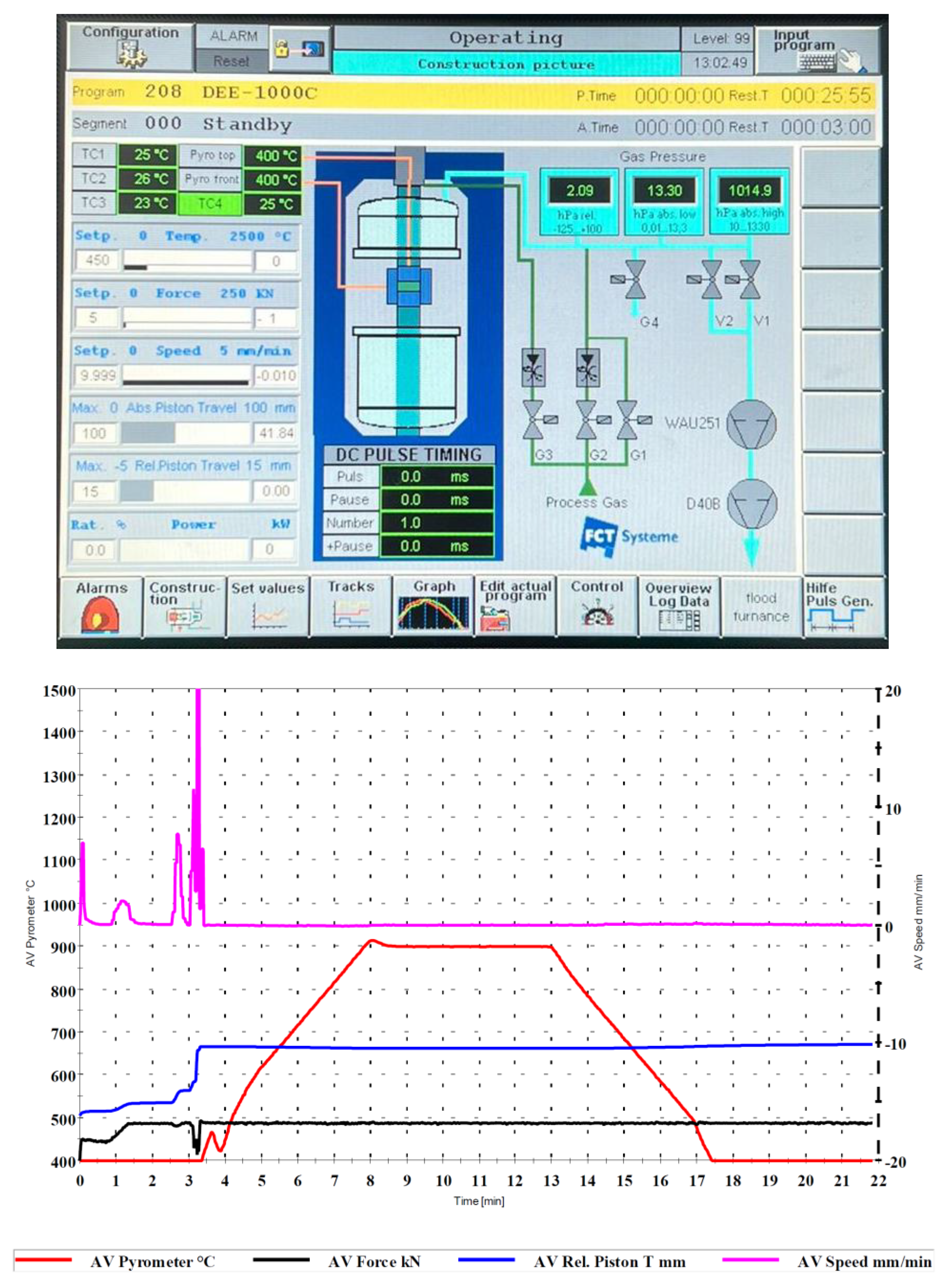
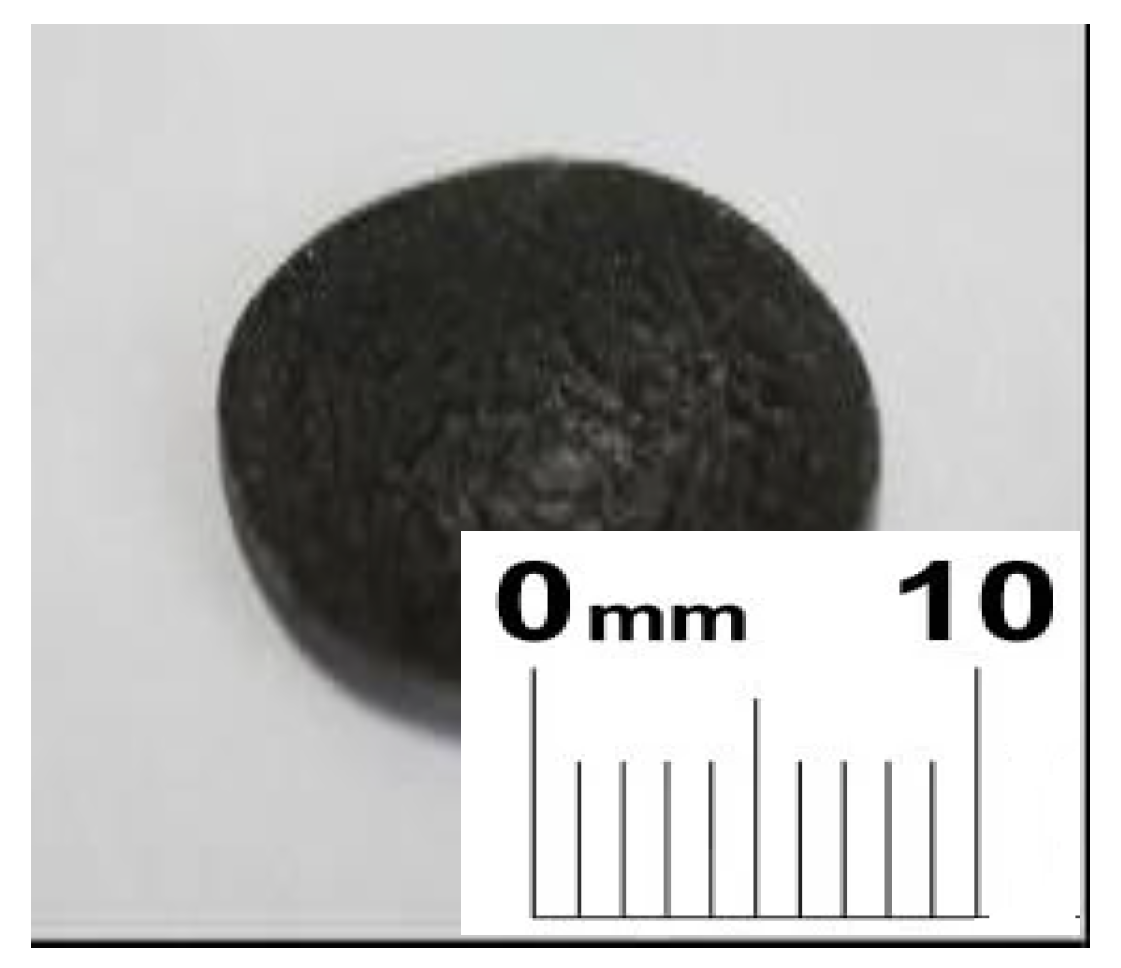


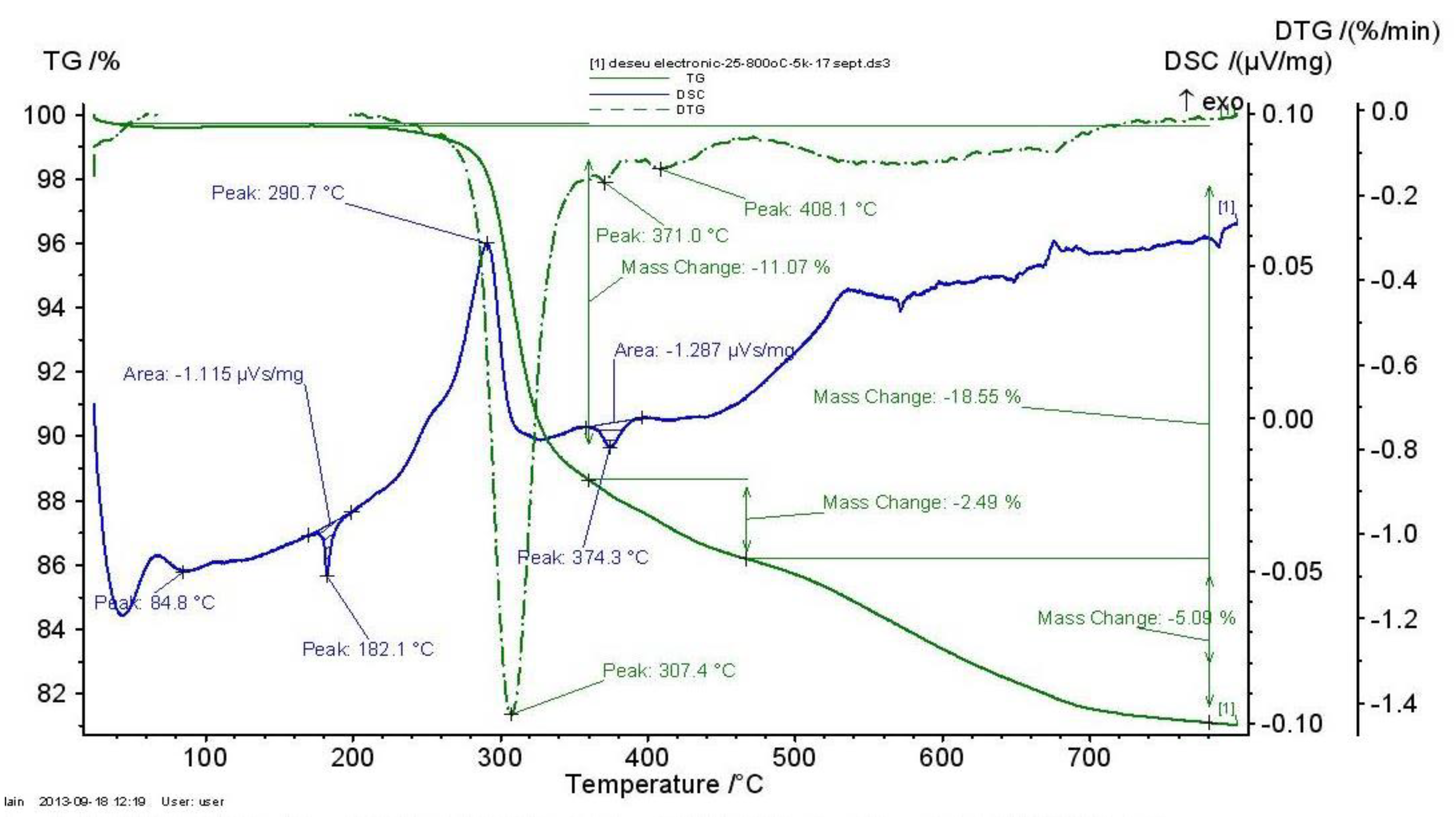
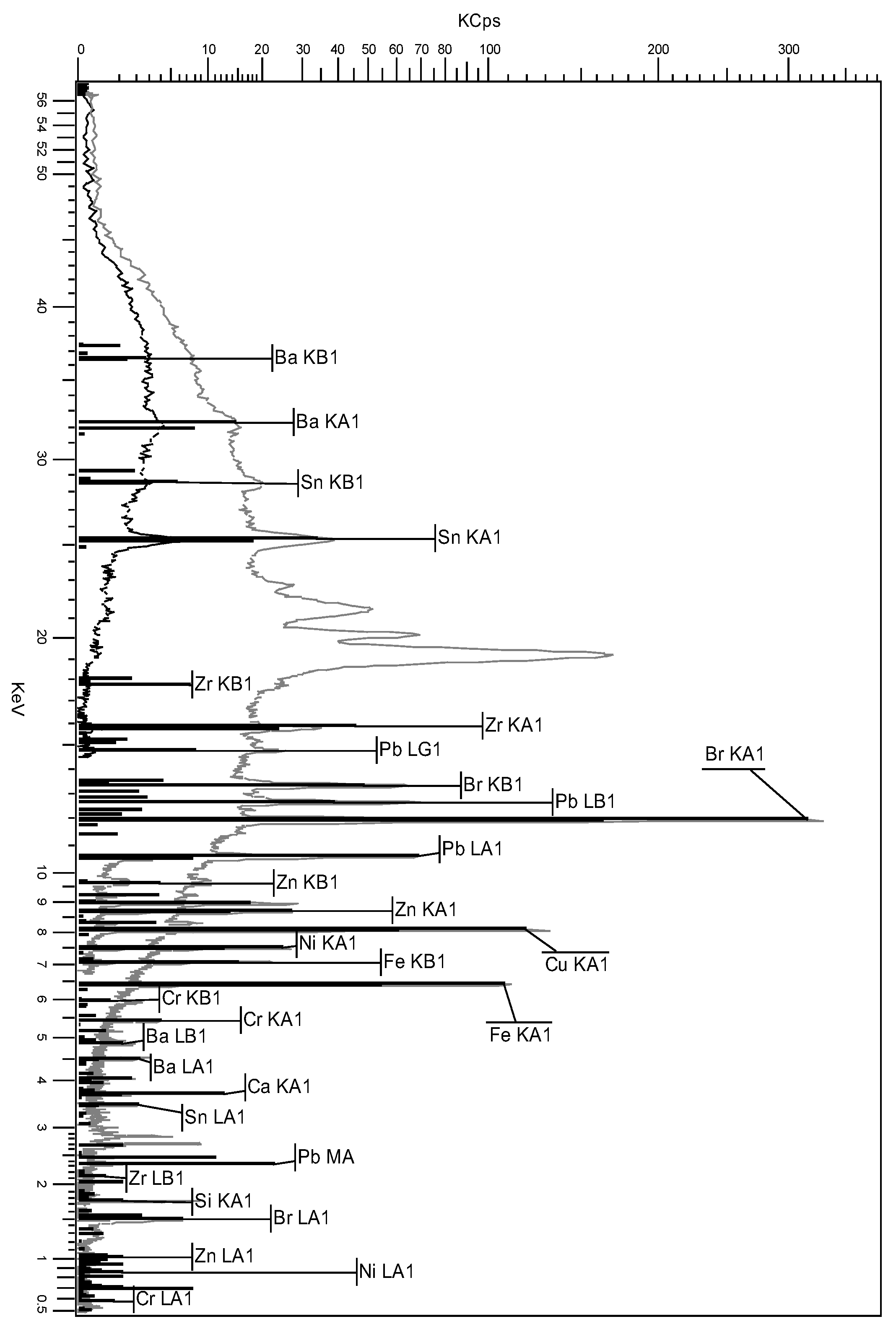
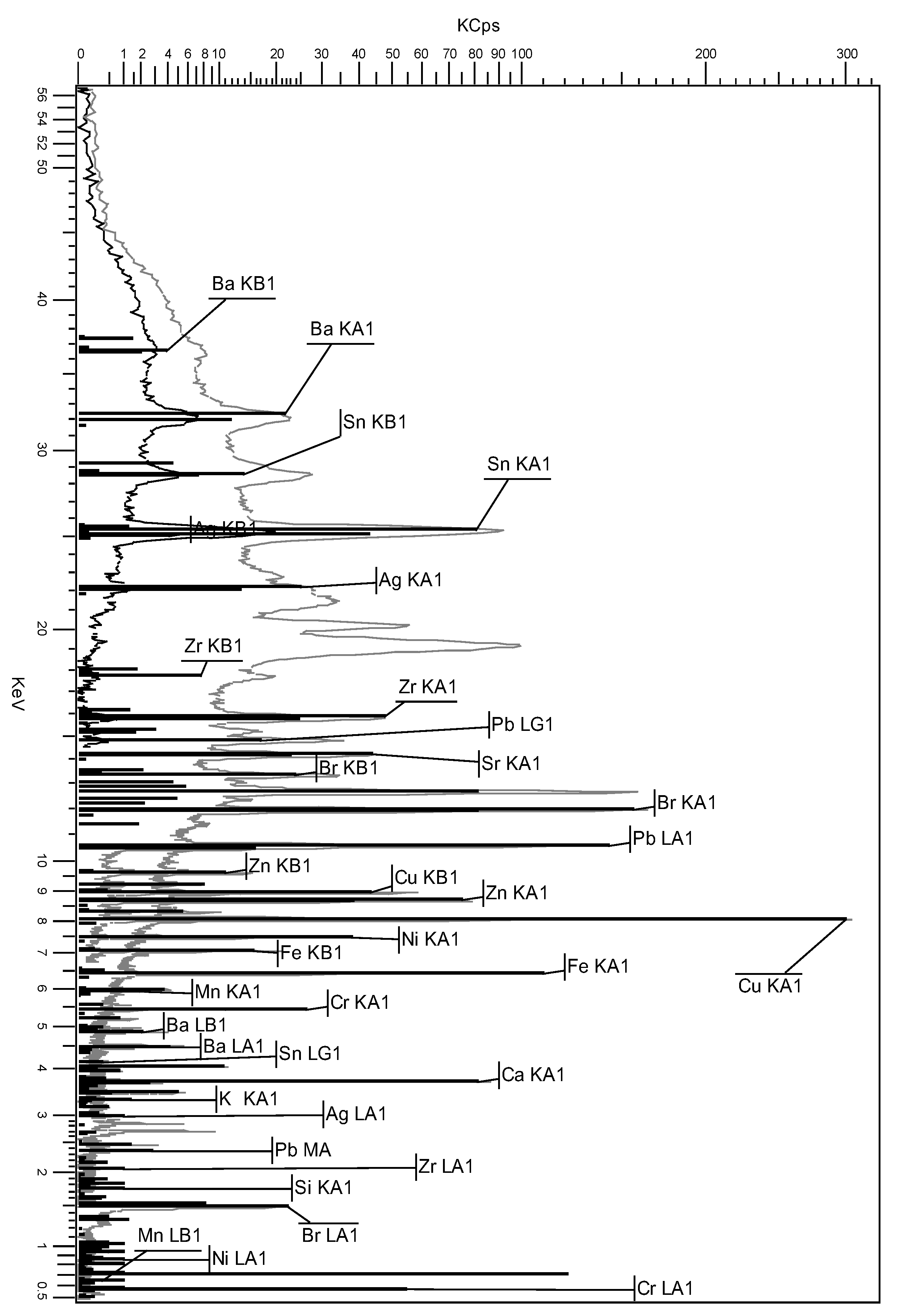
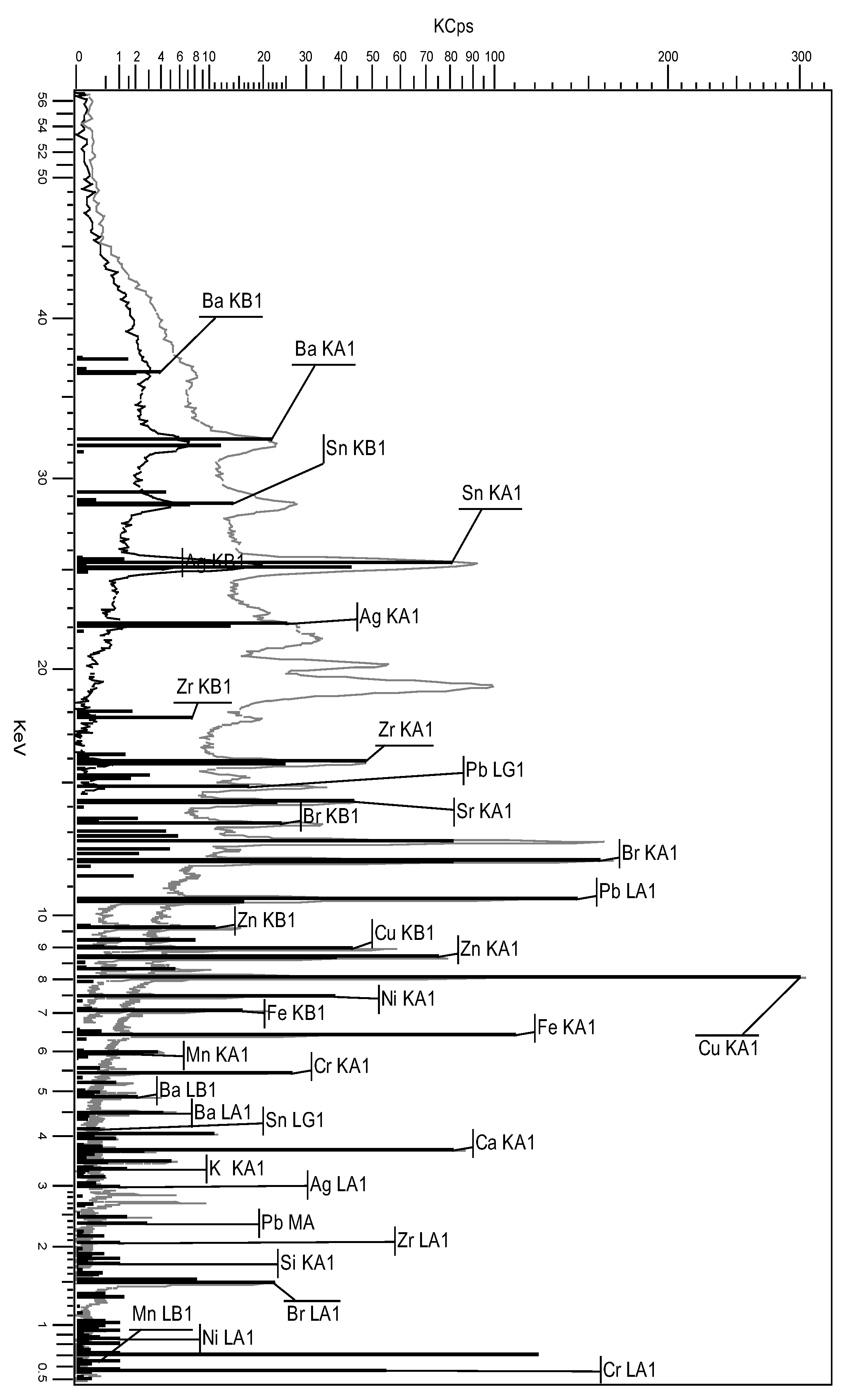
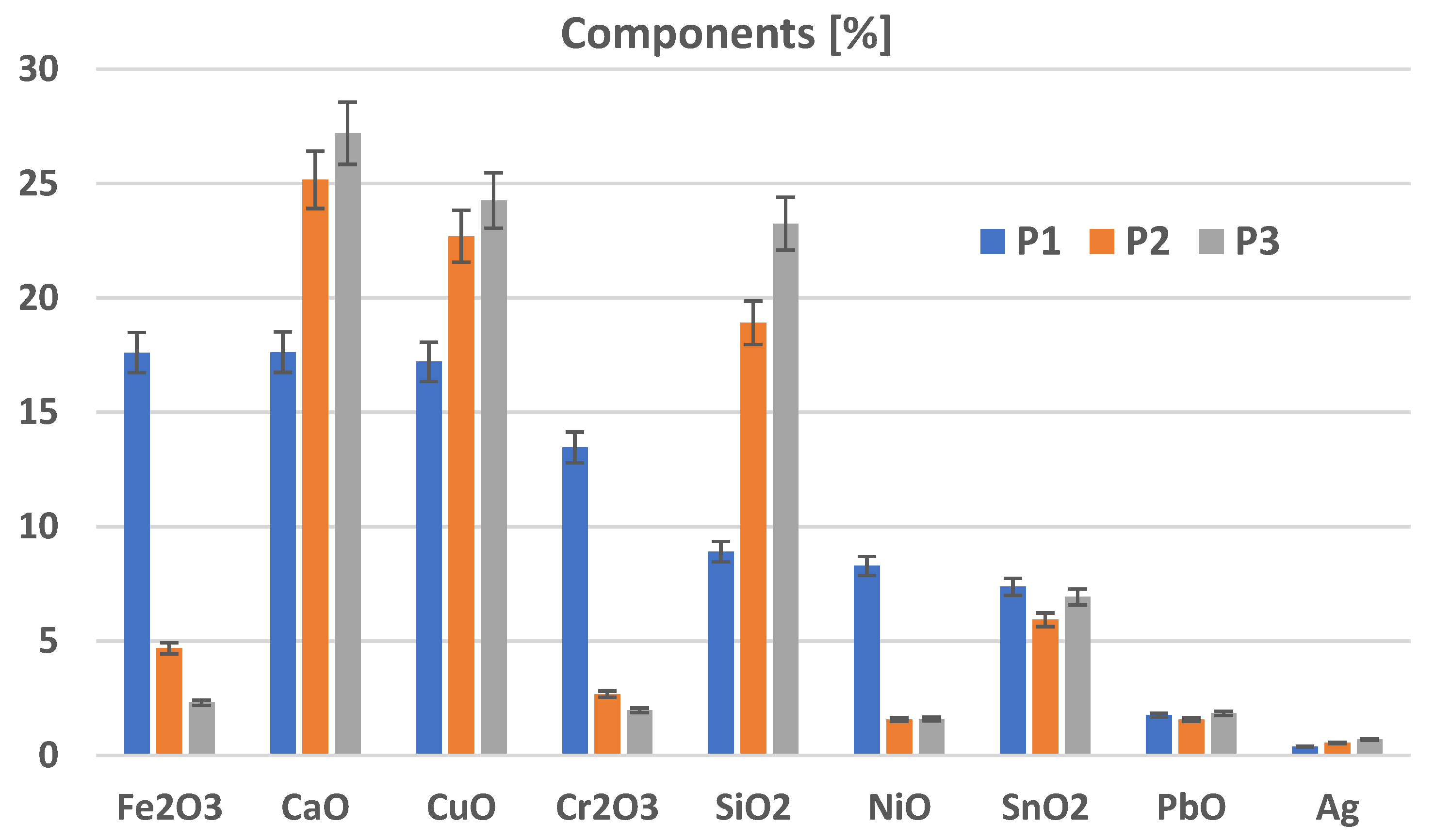
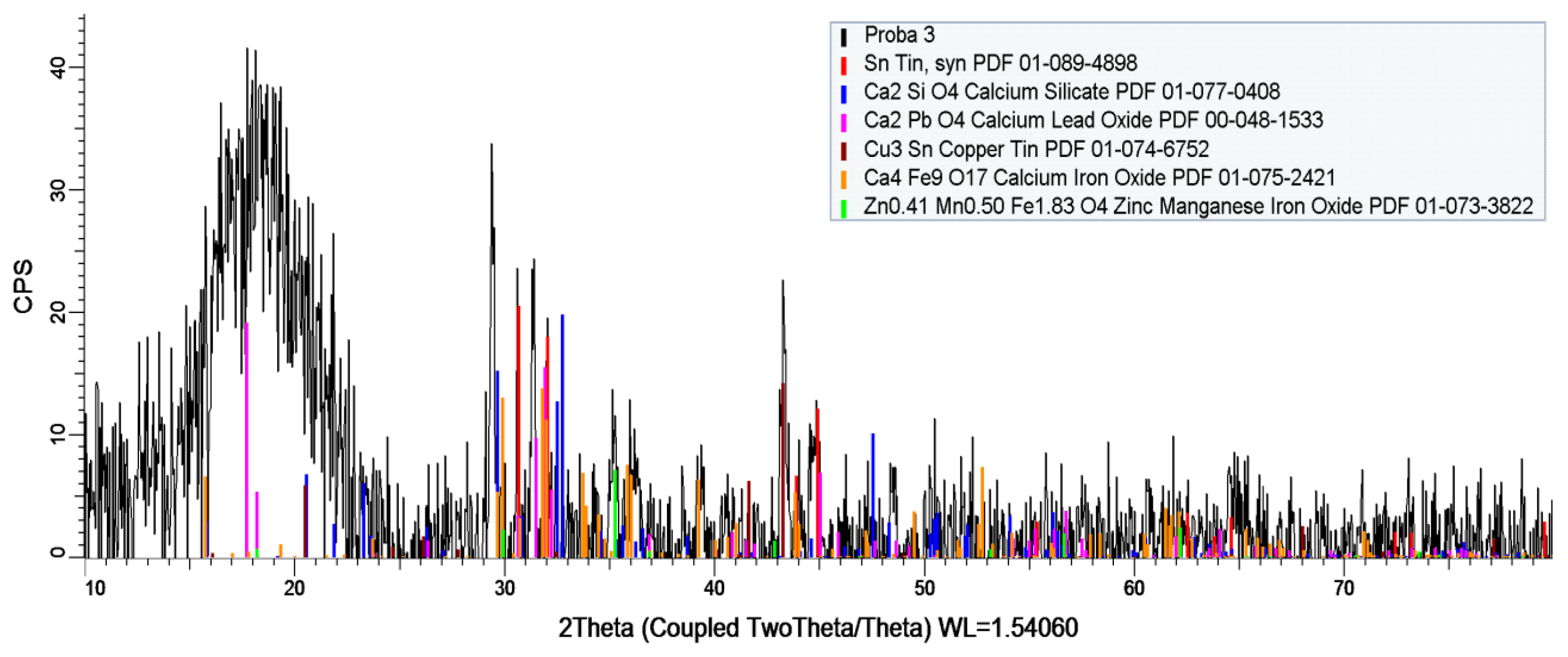

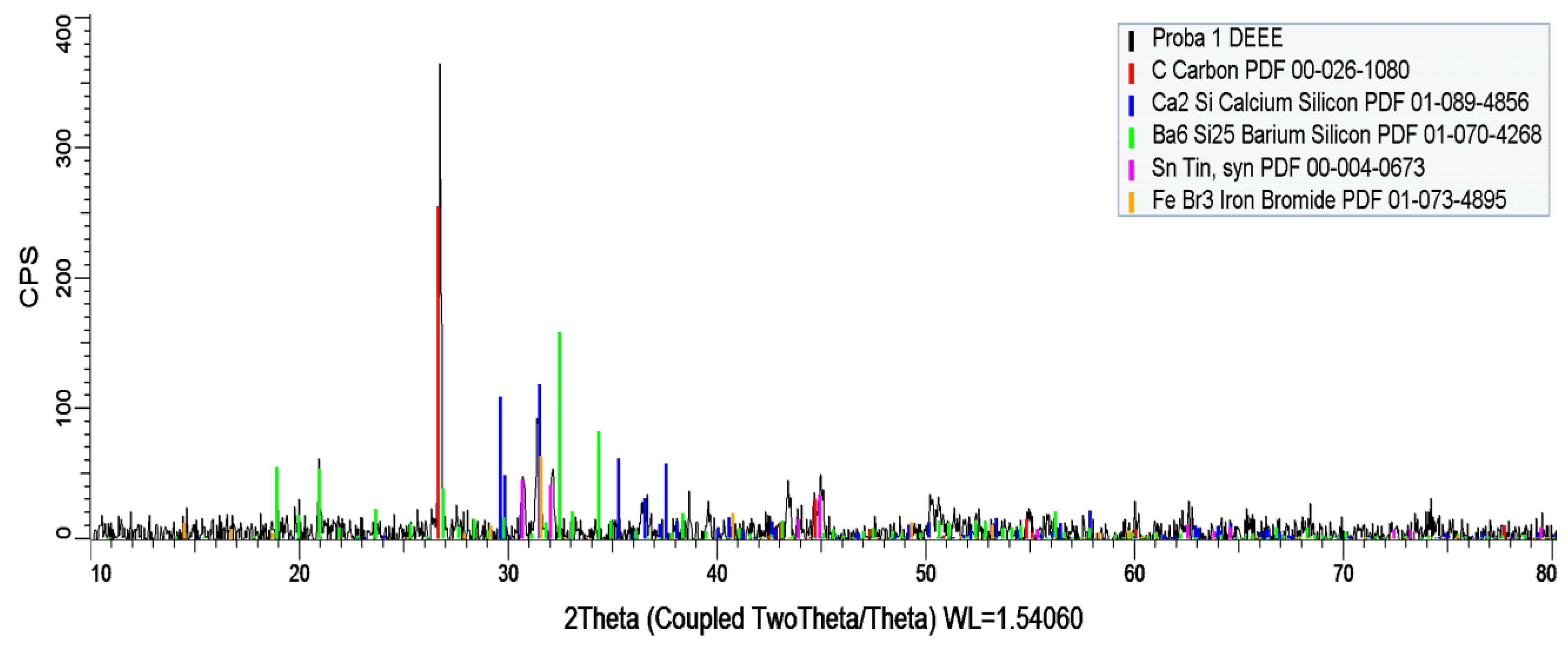
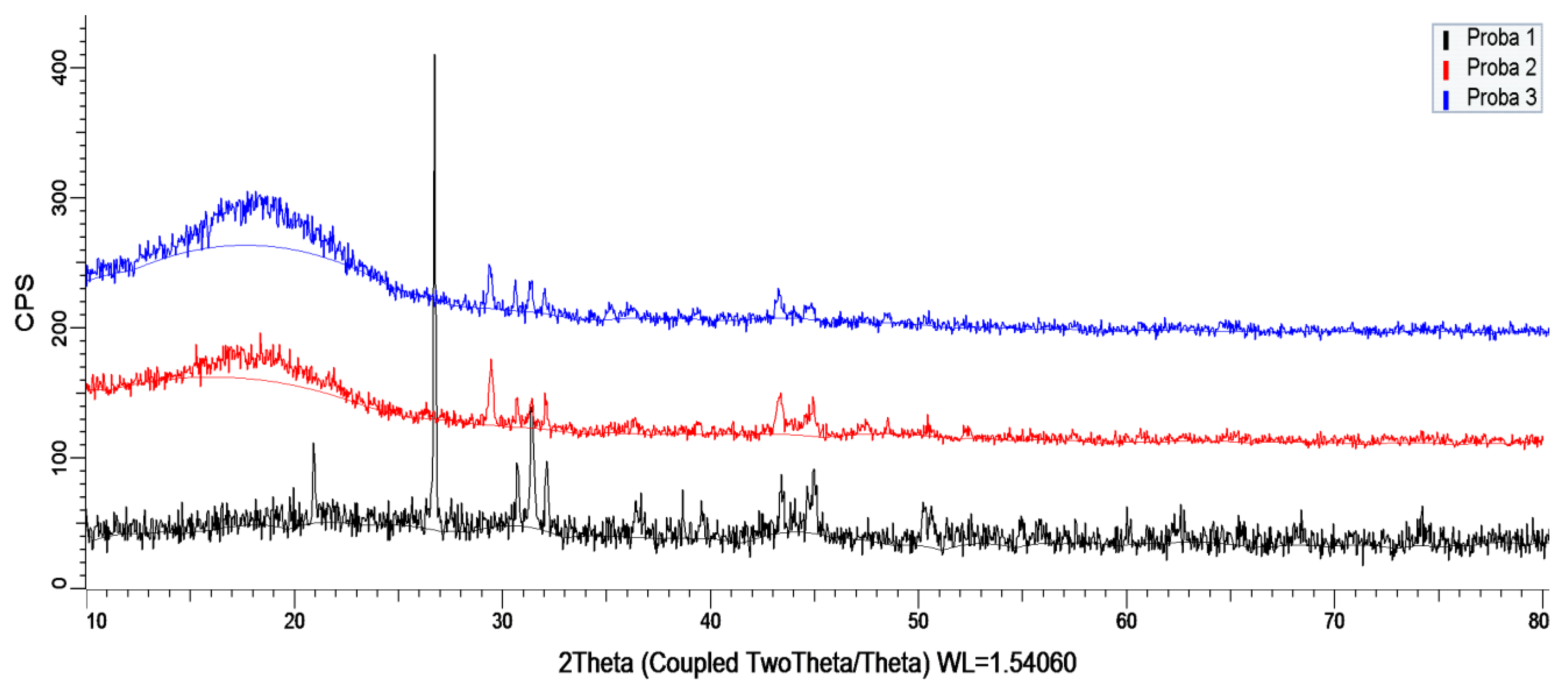




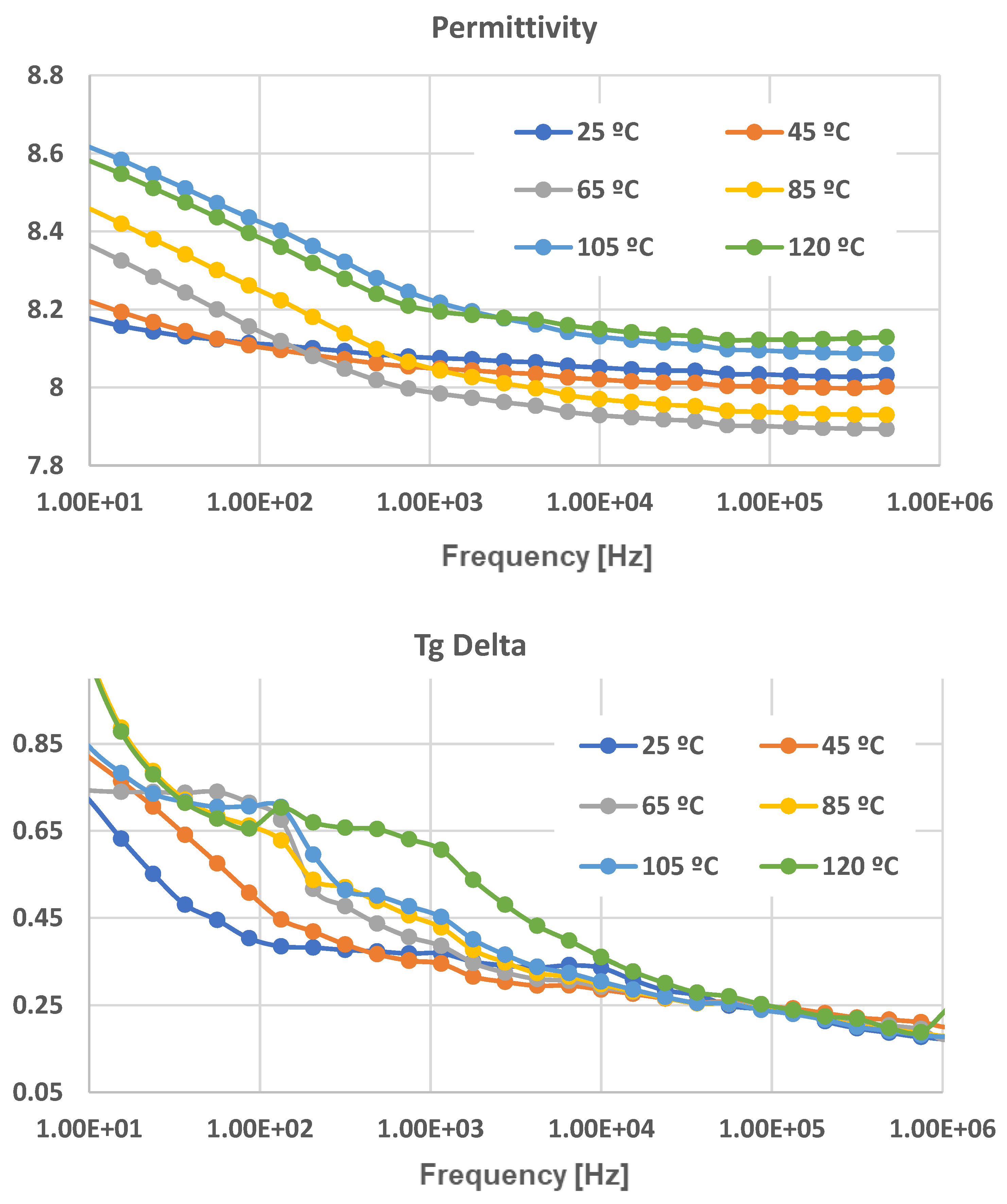
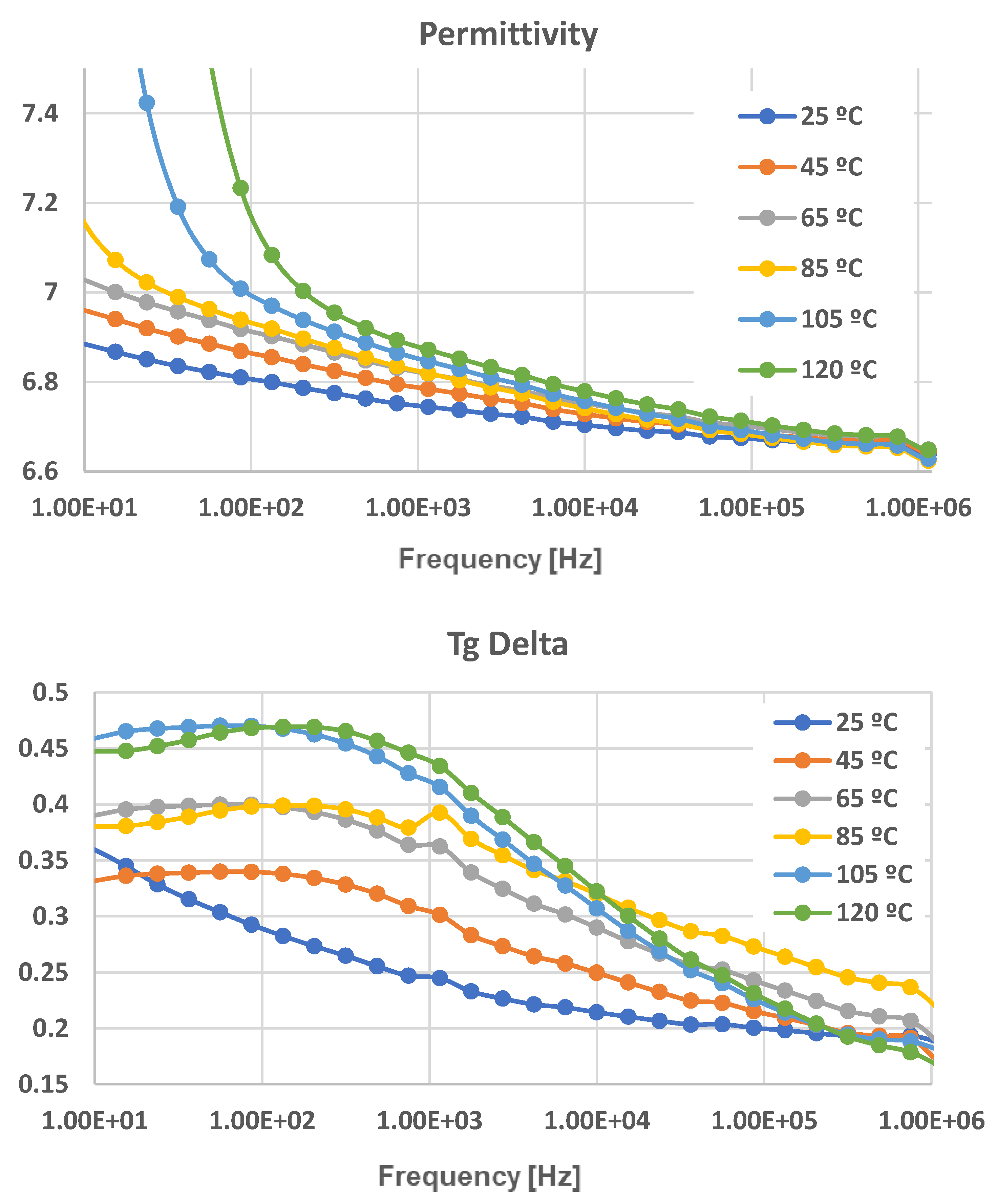
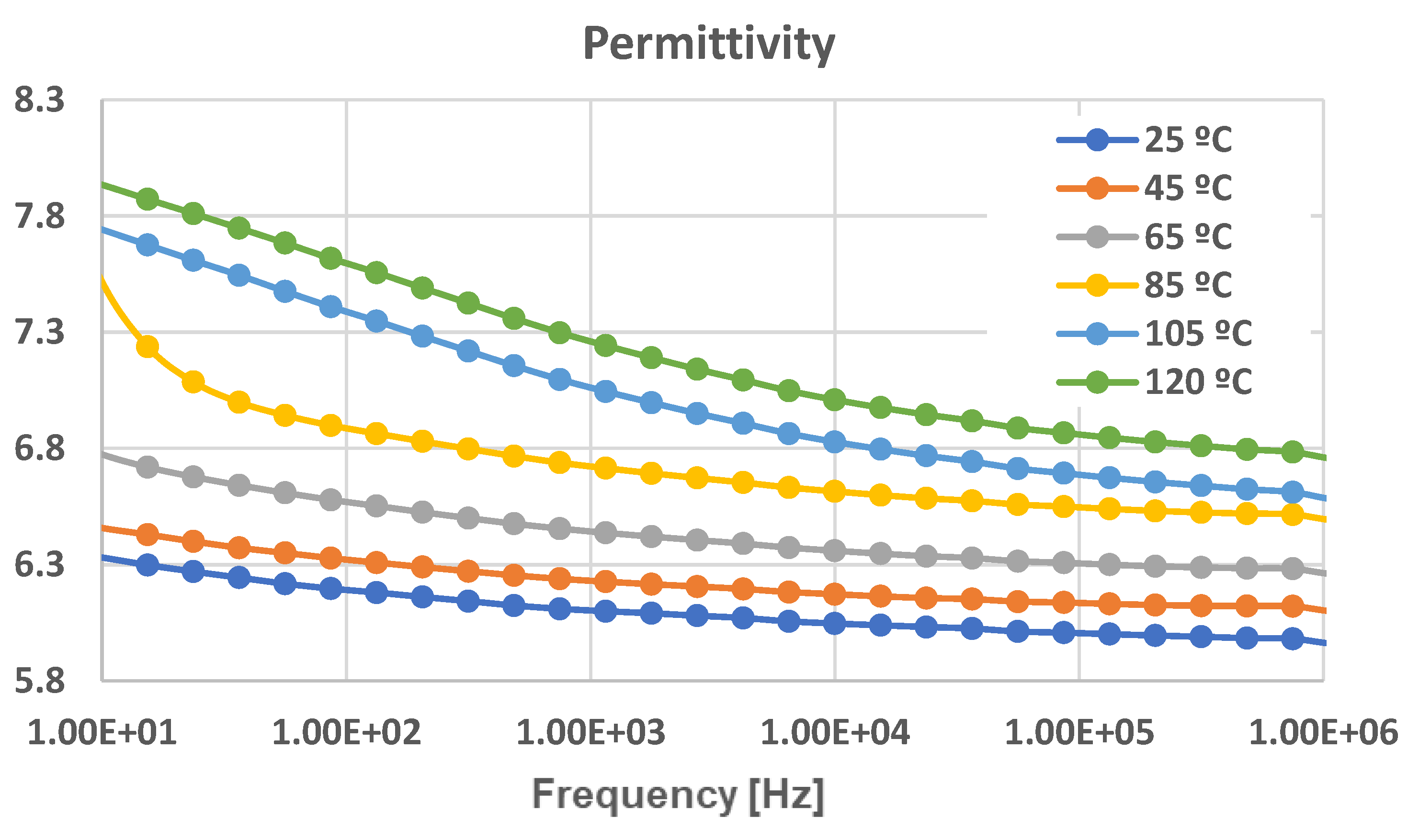


| Sample | ρ [g/cm3] |
|---|---|
| P1 | 0.6630 |
| P2 | 0.6338 |
| P3 | 0.6242 |
| Element | Concentration (%) |
|---|---|
| Fe | 17.96 |
| Si | 17.62 |
| Br | 17.21 |
| Cu | 13.46 |
| Ca | 8.91 |
| Pb | 8.28 |
| Sn | 7.37 |
| Ba | 3.20 |
| Ni | 1.76 |
| Zr | 1.55 |
| Zn | 1.51 |
| Cr | 1.17 |
| Element | Concentration (%) |
|---|---|
| Ca | 25.16 |
| Fe | 15.72 |
| Cu | 13.91 |
| Si | 12.69 |
| Sn | 7.93 |
| Pb | 7.68 |
| Ba | 3.39 |
| Br | 3.10 |
| Cr | 2.68 |
| Zn | 2.61 |
| Mn | 1.88 |
| Ni | 1.57 |
| Zr | 0.69 |
| Sr | 0.61 |
| Ag | 0.38 |
| Element | Concentration (%) |
|---|---|
| Ca | 27.19 |
| Cu | 14.55 |
| Si | 13.43 |
| Sn | 9.93 |
| Fe | 9.30 |
| Pb | 8.84 |
| Ba | 3.80 |
| Br | 3.42 |
| Cr | 3.07 |
| Zn | 2.31 |
| Ni | 1.59 |
| Zr | 0.88 |
| Sr | 0.70 |
| Ag | 0.49 |
| K | 0.36 |
| Mn | 0.14 |
| Sample | Crystallinity Degree [%] |
|---|---|
| P1 | 59 |
| P2 | 35.4 |
| P3 | 16.8 |
| Sample | HV 0.1/10 [kgf/mm2] |
|---|---|
| P1 | 15.91 |
| P2 | 13.64 |
| P3 | 11.28 |
Disclaimer/Publisher’s Note: The statements, opinions and data contained in all publications are solely those of the individual author(s) and contributor(s) and not of MDPI and/or the editor(s). MDPI and/or the editor(s) disclaim responsibility for any injury to people or property resulting from any ideas, methods, instructions or products referred to in the content. |
© 2024 by the authors. Licensee MDPI, Basel, Switzerland. This article is an open access article distributed under the terms and conditions of the Creative Commons Attribution (CC BY) license (https://creativecommons.org/licenses/by/4.0/).
Share and Cite
Ciobanu, R.C.; Aradoaei, M.; Schreiner, C. Technology for Obtaining Sintered Components with Tailored Electromagnetic Features by Selective Recycling of Printed Circuit Boards. Crystals 2024, 14, 820. https://doi.org/10.3390/cryst14090820
Ciobanu RC, Aradoaei M, Schreiner C. Technology for Obtaining Sintered Components with Tailored Electromagnetic Features by Selective Recycling of Printed Circuit Boards. Crystals. 2024; 14(9):820. https://doi.org/10.3390/cryst14090820
Chicago/Turabian StyleCiobanu, Romeo Cristian, Mihaela Aradoaei, and Cristina Schreiner. 2024. "Technology for Obtaining Sintered Components with Tailored Electromagnetic Features by Selective Recycling of Printed Circuit Boards" Crystals 14, no. 9: 820. https://doi.org/10.3390/cryst14090820
APA StyleCiobanu, R. C., Aradoaei, M., & Schreiner, C. (2024). Technology for Obtaining Sintered Components with Tailored Electromagnetic Features by Selective Recycling of Printed Circuit Boards. Crystals, 14(9), 820. https://doi.org/10.3390/cryst14090820





